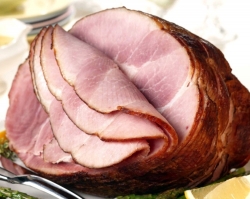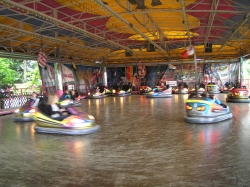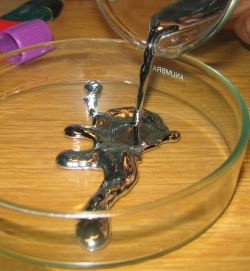Heat can mean comfort. Like a warm blanket. Or hot cocoa. Heat can also mean danger. If your food's too hot, you'll burn your tongue. If your fever is too high, you need a doctor. If it's too hot outside, you may need to sit on a block of ice. Or just turn on a fan. How do we know how hot something is? Easy. We check a thermometer, right? Ah. But how does it know?
It's 76 degrees outside. We cooked that ham at 325 degrees for twenty minutes. He has a 102 degree fever! Without knowing what these numbers mean, you would not know what to do in these cases. Is it safe to go outside without a jacket? Yes. Is that ham cooked enough to eat? Yes. Should he go to the doctor? Probably. How do we know what these numbers mean?
Temperature is a measurement of how hot or cold something is. It will tell you what to wear outside, when your dinner is cooked, and when you are sick. How do you figure out the temperature? Before we answer that, let's look at what temperature is.

This guy really knows how to ham it up.
Have you ever been in a bumper car rink? Have you ever seen popcorn pop at the movie theater? Choose one and think about it going as crazy as possible. At first, the kernels are just sitting on the bottom. The cars are sitting still. But then they start and everything bounces off everything else! This is also how the building blocks of our world act when they heat up. The more energy they have, the faster they move. This is what we call "heat." All of these parts are moving at different speeds too. Some are bumping around super fast and others are just going kind of fast. They keep bouncing off each other and trade their speed back and forth.
When things are moving they have a kind of energy called kinetic energy. You can see this at work when a ball is flying through the air and it hits something. The ball hits with a lot of force, which came from how big it is and how fast it was moving. When we want to tell how hot something is, we just need to know how fast all the little parts of it are moving. Temperature measures the
average kinetic energy, which basically means the average of how fast the building blocks in something are moving. So how do we tell how much the building blocks are crashing into each other? With a tool that is able to tell how many things are crashing into it. It's a good thing it isn't a bumper car. It would probably shatter.

Watch out! Here I come.
Karsten11, Public domain, via Wikimedia Commons
To use a thermometer, put it in a place where you'd like to measure the temperature. You could put it in the oven to test if the chicken is cooked. Put it in your mouth to see if you have a fever. Bring it outside to see if you need a jacket. Liquids take up more room when they are hot. Outside the thermometer, the glass "feels" how fast things are crashing into it. Inside, mercury, which looks like a silver colored liquid, in the bulb at the bottom will heat up and then expand, which makes its level rise up higher. It will get colder when fewer things are bouncing off the glass, and then the mercury will contract, which makes the level go down. The numbers the mercury touches on the long, thin part of the glass will tell you the temperature. So why this silver colored stuff?
Mercury is a liquid that has a very high boiling point and a very low freezing point. The reason you will not see water in a thermometer is that if it was too cold, it would turn into ice. If it was too hot, it would boil, and might break the glass. Mercury works great. There's just one bad thing . . .

Mercury; do not touch!
Mercury is bad for your health. Your thermometer can work very well until it breaks open and everyone has to cover their mouths while someone cleans it up. A few years ago, someone came up with the great idea of putting something else in the glass instead. An
alcohol thermometer uses a kind of alcohol to tell out how hot or cold something is. Like mercury, it has a high boiling point and a low freezing point so it can measure almost anything you need to. If it breaks open, you do not have to be worried. Just do not drink it. This is a very different from the kind of alcohol people drink!
Thermometers are a good way to stay safe when it comes to heat and cold. With this tool, you can eat the right foods, dress the right way before you go outside, even find out if you need to go to the doctor or not. Some thermometers are better than others. We are finding new ways to figure out how hot or cold it is in better, safer ways. Just remember, if your thermometer breaks, try to stay away from what comes out. Better yet, be careful with your thermometer in the first place.
References:Science Kids. "Weather Facts: Temperature Facts" Science Kids, 2012. <
http://www.sciencekids.co.nz/sciencefacts/weather/temperature.html>
Brain, Marshall. "How Thermometers Work"
HowStuffWorks.com. 2000. <http://home.howstuffworks.com/therm.htm>